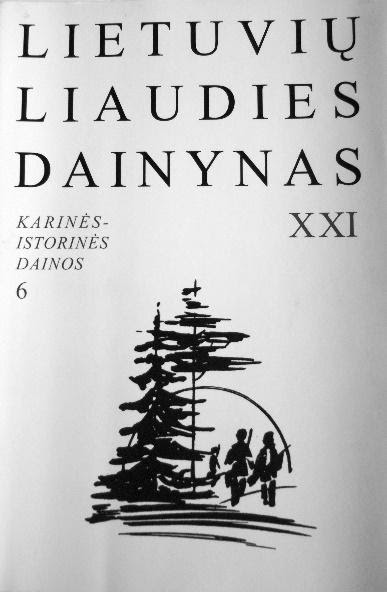A large and continuously updated collection of magnetic sound recordings is housed at the Lithuanian Folklore Archives (magnetic tapes and audiocasettes amounting to around 8,500 hours). The first sound recordings were made on magnetic tape in 1952 when fighters of the national resistance were still hiding in Lithuania’s forests, and were persecuted by the secret service of the Soviet Union. At that time, a new style of song was being sung in Lithuanian villages, created by the resistance fighters themselves as well as their supporters — village poets. These songs told of the fate of the resistance fighters, their battles and deaths. The notebooks in which these songs were recorded were hidden away because any contact with resistance fighters, uncovered clues, or any compromising materials, risked the threat of imprisonment or deportation. The folklore collectors were unable to record these songs as well, because if the Management of the Institute found out, they would be fired. However, in the later Soviet years some of the songs “slipped through” and wound up in the archive (some of the first recordings of these songs were made in 1978). Once the national independence movement started, the resistance songs were sung in public and documenting them became a priority. Thus, an especially large number of these songs were recorded in the 1990s. Drawing on the underground resistance press and the newly gathered material, a volume of resistance fighters’ songs was compiled and published:

Book of Lithuanian Folk Songs, vol. XXI. War-Historical songs, vol. 6 - Resistance songs. Compiled by Kostas Aleksynas, melodies were prepared by Živilė Ramoškaitė. Vilnius: Institute of Lithuanian Literature and Folklore, 2009.
From 2012–2014, together with other academic institutions, the Institute of Lithuanian Literature and Folklore executed the project supported by EU structural funds “Development and Providing Access to IRT Solutions and Content Helping to Preserve the Lithuanian Language in Public Space”. As part of this project, folklorists of the Institute began compiling the digital card catalogue of songs of the post-World War II armed resistance movement , as well as digitizing the magnetic tapes and cassettes on which these songs were recorded. In the Lithuanian Folklore Archives database, a collection of sound recordings of post-war resistance fighters’ songs was created (1,197 items). We invite you to listen to the archival recordings.
| Fondas: | LTRF k |
| Signature: | LTRF k 368 |
|
Song title : | Vaido Satkūno tautosakos rinkinio garso įrašas |
| Dokumentų rūšys: |
1. garso įrašai
|
| Apimtis (kiekis): |
1. min:s: 80:11 |
| Kalbos: |
1. lietuvių |
| Susiję ištekliai: |
1. LTR 6620
|
| Fondo dokumentai: |
LTRF k 368-01 Ko siratų pulkas sodely verkė
LTRF k 368-02 Kaip siratėlei pasisekė
LTRF k 368-03 Pasaka apie siratytę muzikantą ir kvailą žmoną
LTRF k 368-04 Kol velnias kryžiaus bijo
LTRF k 368-05 Apie velnią ir ožį
LTRF k 368-06 Kaip netikro velnio išsigando
LTRF k 368-07 Mįslė
LTRF k 368-08 Kaip atsirado Kairionių ulyčia
LTRF k 368-09 Pasakojimas apie įsimylėjėlius
LTRF k 368-10 Oi bernioke, tu beširdi
LTRF k 368-11 Kaip merga piršlius apgavo
LTRF k 368-12 Patarlės ir priežodžiai
LTRF k 368-13 Nekask kitam duobės, ba pats ingriūsi
LTRF k 368-14 Oi Lietuva motinėle
LTRF k 368-15 Saulutė ruošėsi tekėt
LTRF k 368-16 Ant gatvės lietuvis gulėjo
LTRF k 368-17 Pilnas pievas gėlių raudonųjų
LTRF k 368-18 Liūdnas mano žirgas
LTRF k 368-19 Močiute širdele
LTRF k 368-20 Vai diemedi, diemedžio šaka
LTRF k 368-21 Anoj pusėj Dunojėlio
LTRF k 368-22 Daug daug dainelių
LTRF k 368-23 Miglotas rytas tankus pušynas
LTRF k 368-24 Papročiai
LTRF k 368-25 Oi tu, rugeli, tu žiemkentėli
LTRF k 368-26 Kaip seniau leisdavo kariuomenėn
LTRF k 368-27 Aušta aušrela
LTRF k 368-28 Kai aš grėbiau lankoj viena
LTRF k 368-29 Ant ežero pakrantės
LTRF k 368-30 Oi diemedi, diemedėli
LTRF k 368-31 Už kalnelio pro giružę
LTRF k 368-32 Mūsų kaimely daugel jaunimo
LTRF k 368-33 Sudieu, sesutės lietuvaitės
LTRF k 368-34 Sakyk, sesute, ar tau negaila
LTRF k 368-35 Aik, sesute, darželin
LTRF k 368-36 Šių naktelį per naktelį
LTRF k 368-37 Mažytėj pirkelėj ratelis vis sukas
LTRF k 368-38 Sėdžiu ant krantelio
LTRF k 368-39 Už gimtinės klonių
|
| Anotacija: |
Garso įrašą sudaro 26 liaudies dainos, 1 sakmė, 3 pasakos, 5 pasakojimai, 1 mįslė, 11 patarlių ir priežodžių, 2 etnografiniai aprašai. |
| Bendras turinio vienetų kiekis: |
39 |
| Duomenų klasifikacija (žanrinis skirstymas): |
1. LIAUDIES DAINOS (1, 10, 14-23, 25, 27-39)
2. SAKMĖS (2)
3. PASAKOS (3, 4, 13)
4. PASAKOJIMAI (5, 6, 8, 9, 11)
5. MĮSLĖS (7)
6. PATARLĖS (12)
7. PRIEŽODŽIAI (12)
8. ETNOGRAFINIS APRAŠAS (24, 26)
|
| Pateikimo būdas: |
1. vokalinis folkloro pateikimas (Pastabos: apsk. vnt.: 1, 10, 14-23, 25, 27-39)
2. sakytinis folkloro pateikimas (Pastabos: 2-9, 11-13, 24, 26)
|
| Užrašymo metų pastabos: |
Užrašymo metai nenurodyti. |
| Užrašytojas: |
Vaidas Satkūnas |
| Užrašymo vieta: |
Kairionys k., Luokesos sen., Molėtų r. sav., Utenos apskr. (originale: Kairionių k., Molėtų r. )
|
| Pateikėjai: |
1. Marė Stalnionienė-Umbrasaitė , gyvenamoji vieta:
Kairionys k., Luokesos sen., Molėtų r. sav., Utenos apskr., kilmės vieta: Kairionys (apsk.vnt: 1-18, 21, 24-39)
2. Leokadija Umbrasienė-Umbrasaitė , gyvenamoji vieta:
Kairionys k., Luokesos sen., Molėtų r. sav., Utenos apskr., kilmės vieta: Kairionys (apsk.vnt: 19, 20, 22, 23)
|
| Kitų žmonių įnašai: |
1. Mantas Lapeika - skaitmenino |






